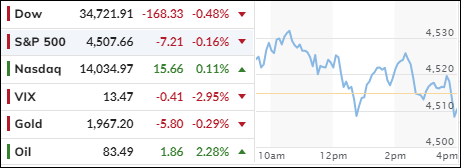
- Moving the markets
The stock market had a roller-coaster ride on Thursday, as an early rally fizzled out and left only the Nasdaq in the green. The other two major indexes closed slightly lower, snapping a 4-day winning streak. The month of August was a bumpy one for stocks, as the S&P 500 trimmed its losses from nearly 5% to less than 2%. Small caps suffered the most, as they usually do in turbulent times.
Inflation remained a hot topic, as the Fed’s preferred measure, the Core PCE Deflator, rose to 4.2% year-over-year in July, matching expectations but higher than June’s 4.1%. The headline PCE also jumped to 3.3%, the highest since June 2022. But if you take out the housing component, which accounts for a large chunk of consumer spending, inflation is still stuck at elevated levels, as this chart shows.
Bond yields were initially falling, which boosted stocks, but then reversed course and started to climb, which dragged stocks down. It seems that stocks are following bonds closely these days, so lower yields could mean higher stock prices in the near term.
The labor market showed mixed signals, as initial jobless claims dropped to 2023 lows despite a surge in layoffs, but continuing claims rose above 1.7 million last week. The economic recovery seems to have hit a speed bump in August, as various indicators showed the biggest monthly decline since May 2022. The data was also inconsistent, with some measures showing strength and others showing weakness.
The dollar had a strong month, rising the most since February, but has been trading sideways for the last two weeks. The Fed has been talking tough about tapering and hiking rates, but the market is not buying it. The market is pricing in 1.1% of rate cuts by the end of next year, which could be a big mistake if the Fed follows through on its hawkish rhetoric.
The bottom line is that the market is facing a lot of uncertainty and volatility, and we need to be prepared for more swings ahead.
2. “Buy” Cycle Suggestions
The current Buy cycle began on 12/1/2022, and I gave you some ETF tips based on my StatSheet back then. But if you joined me later, you might want to check out the latest StatSheet, which I update and post every Thursday at 6:30 pm PST.
You should also think about how much risk you can handle when picking your ETFs. If you are more cautious, you might want to go for the ones in the middle of the M-Index rankings. And if you don’t want to go all in, you can start with a 33% exposure and see how it goes.
We are in a crazy time, with the economy going downhill and some earnings taking a hit. That will eventually drag down stock prices too. So, in my advisor’s practice, we are looking for some value, growth and dividend ETFs that can weather the storm. And of course, gold is always a good friend.
Whatever you invest in, don’t forget to use a trailing sell stop of 8-12% to protect yourself from big losses.
3. Trend Tracking Indexes (TTIs)
The stock market gave up its early gains on Thursday, as rising bond yields put pressure on stocks and dragged them lower by the end of the day.
Our TTIs also declined slightly, but not enough to affect our invested positions. We remain bullish on the market outlook, as long as our TTIs stay above their long-term trend lines.
This is how we closed 08/31/2023:
Domestic TTI: +3.02% above its M/A (prior close +3.38%)—Buy signal effective 12/1/2022.
International TTI: +4.53% above its M/A (prior close +4.81%)—Buy signal effective 12/1/2022.
All linked charts above are courtesy of Bloomberg via ZeroHedge.
Contact Ulli